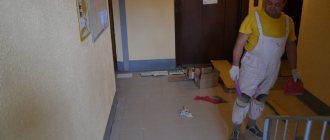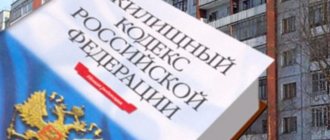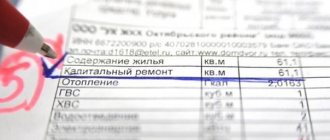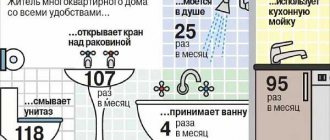Author of the article
Alexander Georgievich Kondratiev
An electrical engineer by training, he worked as an electronics engineer, chief engineer at a food company, and general director of a construction organization.
Repair work in apartment buildings is divided into capital and current. Current repairs of an apartment building keep the apartment building in a safe condition and ensure comfortable living for residents. Performed regularly, according to schedule. The work is paid for by the residents of the house. They have the right to control the quality of work performed by the contractor. And also require the management company to perform these works.
Normative base
The company servicing an apartment building is obliged to regularly check the condition of residential buildings and promptly eliminate any defects that arise.
The Housing Code of the Russian Federation (Article 154) determines the list of current repair services that housing and communal services workers should follow. In addition to the Housing Code, this list was approved by Decree of the State Construction Committee No. 170 of September 27, 2003. See the list of main works below.
In their work, management companies are guided by the methodological manuals of the State Construction Committee MKD-2.04.2004.
Current repairs of residential buildings are not the elimination of emergency situations, but planned work that is carried out on a regular basis according to schedule. They are discussed and approved at a general meeting of homeowners.
On it, residents, together with management company employees, approve the frequency of work. Residents are introduced to what is included in routine repairs. It is performed no more than once a quarter.
Repair of common property in an apartment building is a set of measures that maintain it in a condition that meets the requirements of the Housing Code. What is enshrined in the Law of the Russian Federation PP No. 491, paragraph 18 of August 13, 2006.
Property maintenance scheme
The building maintenance system consists of a set of measures aimed at maintaining the reliability of the building itself and maintaining the functioning of mechanisms and engineering systems (heating, elevators, lifts, climate systems, fire extinguishing systems, warning devices, lighting and much more).
The equipment must receive the necessary engineering maintenance and timely repairs. In addition to repairs, adjustments are also required. Unfortunately, today a common practice is to install complex systems and not have an installer who knows how to configure it all. This leads not only to a deterioration in the quality of operation of such a building, but also causes premature equipment breakdowns due to overloads and resource depletion.
Proper maintenance of building engineering systems not only keeps these systems in working order and makes staying in the building comfortable, but is also a safety requirement. After all, various malfunctions are possible in the functioning of the systems (for example, a person can be scalded by hot water), and the wear of load-bearing structures is fraught with the risk of parts of the wall or roof falling. Of course, this cannot be allowed.
The main goal of automating scheduled equipment repairs is to ensure the safety of engineering equipment in working order with the established performance characteristics through proper care of it, timely and high-quality maintenance, as well as streamlining the repair business and reducing the cost of repairs.
According to the methodology discussed in the article, the operation of the building is automated. We talked about the program for automating the operation of a building in this article (will open in a new tab), where we showed with an example how you can automate the process of operating a building using 1C: MRO software.
What is the difference from a major overhaul?
The very concept of a major overhaul indicates the scale of the work. They are carried out with a complete replacement, for example, of electrical wiring or drainage and water supply systems. It is carried out to prevent wear and tear of the building. Major repairs are planned in advance. The Housing and Communal Services Department draws up plans for major repairs for many years to come. Their frequency is several years. Work may take several months.
Current repairs of apartment buildings are planned and preventive; they are needed to maintain utility networks in working order. For example, partial replacement of communications, troubleshooting, painting, whitewashing is carried out. Current work is carried out as planned in strict accordance with standards.
Current repairs are characterized by a short duration. The service is provided for a fee; residents transfer funds for it on a monthly basis. While major repairs may be partially subsidized by the state.
Fundamentals of reliable operation of building engineering equipment
The reliability of a building depends on the correctness of its maintenance and compliance with regulated maintenance periods.
If there is no reliability, then there is a risk of injuring the user of the building or making its use very uncomfortable. In addition, if reliability decreases, then this is the first signal for the need for a comprehensive replacement of many key components and mechanisms. A failed mechanism can break other mechanisms working “in the same bundle.” This means that investments for repairs will require much more significant.
The most pressing issue is the operation of building engineering systems . Modern equipment, as a rule, is installed in “as is” mode. No one knows how to set it up, and improper maintenance of engineering systems causes a lot of trouble. If previously it was enough to add oil to the generator at the right time, now this is not enough at all. Any engineering mechanism is equipped with an electronic system or operation controller. Both the quality of operation of this device and the operation of all these auxiliary electronic units depend on compliance with the maintenance regulations. Now there are special programs for the operation of buildings and structures.
In order to properly organize the process of maintaining the building and its engineering systems, a system of scheduled preventive maintenance (PPR) was developed.
Who is responsible
The law requires that the work schedule be approved at a general meeting of residents, but usually it is impossible to assemble a quorum. Therefore, these functions are delegated to employees of the service enterprise (management company). The management of the management company draws up an annual plan, which can be promptly adjusted.
Current repairs in an apartment building are the responsibility of the management company, but it has the right to hire contractors. For this purpose a competition is organized. The initiators of purchases are homeowners, an authorized representative, a homeowners association or a management organization acting on the basis of a signed agreement.
The owners or a representative of an authorized company are required to control the quality of services provided. If there are suspicions that utility services are provided improperly or not in full, specialists from the State Housing Inspectorate are involved.
After completion of the work, an act is drawn up and signed by the commission. It includes representatives of the contractor, an authorized representative and a representative of the owners of the apartment building. When controversial issues arise, independent experts are involved.
Organization of reconstruction
After the work plan has been drawn up and the estimate has been developed, the management organization must ensure that repair work is carried out. Cosmetic repairs can be organized either by the management company’s employees or by a third-party contractor.
IMPORTANT: it should be remembered that the owners do not have to make any additional contributions, since, in accordance with Article 154 of the Housing Code of the Russian Federation, payment for all current work is already included in the payment for the premises and utilities.
Current repairs are considered completed only after the contractor demonstrates the repaired entrance and the residents sign the Work Acceptance Certificate.
List of main works
Sometimes management companies try not to tell residents of apartment buildings what types of work are included in the current repair plan. This makes it easier to write off money for increasing volumes and not carry out some of the work on routine repairs. Therefore, the “manager” needs to be controlled.
And for this you need to know what is involved in current repairs.
- Leveling local deformations, restoring sections of foundations, clearing ventilation ducts, repairing basement entrances and collapsed blind areas.
- Restoration of walls, sealing of joints.
- Painting of external and internal walls, ceilings.
- Replacement of broken glass and restoration of frames.
- Correction of defects in entrance areas, such as vestibule, etc.
- Removing minor defects in inter-apartment partitions and giving them rigidity.
- Partial repair of water supply, sewerage, central heating systems, local boiler houses, hot water supply and pumping units of apartment buildings.
- Elimination of defects in electrical supply systems, including electric stoves. However, indoor appliances are not included in this list.
- Ensuring the functioning of indoor ventilation.
- Floor restoration.
- Painting or replacing mailboxes.
- Painting of metal parts and radiators of the heating system installed in common areas.
- Minor fixes to stair railings and installation of handrails.
- Dismantling and installation of lamps.
- Restoration of electrical interfloor panels or installation of serviceable ones.
- Installation of canopies over entrance groups. They can be made of metal or welded materials.
- Restoration of aprons on a garbage chute.
This is a list of the main types of work. The management company is not required to include all of these items in every ongoing repair. They are performed as needed. For example, if the canopies over the entrance require repair, then this item is included in the list. If the visors are in order, then they are not touched.
Residents have the right to take the initiative: write an application to the management company so that certain work is included in the plan.
Planning costs for current repairs of residential buildings based on aggregated indicators
At the moment, the main document defining the requirements and procedure for repairing residential buildings is the Rules and Standards for the Technical Operation of the Housing Stock. The standards, as a technical document, regulate the scope of work during routine repairs of residential buildings, the service life of structures before major repairs, but the standards do not indicate the deadlines for performing routine repairs.
Current repairs are currently carried out in accordance with the actual condition of buildings according to schedules of scheduled preventive maintenance. The planning horizon is usually 1 year. The annual program includes all foreseeable (and, accordingly, planned) repair work, the need for which in the year under review was determined during the inspection.
Since planning the resource provision and financing of work on the current repair of the housing stock is in fact unacceptable, aggregated indicators of the cost of repair work are proposed for practical use, which are based on current technical standards and take into account the influence of factors related to the specifics of the object and the conditions of its operation.
The development of the proposed indicators was carried out sequentially. To begin with, the residential building was assigned to a certain capital group. The current standards for residential buildings establish six capital groups. Since the problem of planning current repairs is legitimate primarily for buildings of capital groups I–III, which are distinguished by a high standard service life (100–150 years) and the presence of main load-bearing structural elements with different service life, the scope of work takes into account the operating conditions of these particular buildings as much as possible.
Then the composition of the repair work regulated by the standards was optimized, and the work packages were enlarged by structural elements. A detailed classification of structural elements recommended by the standards for planning current repairs is impractical, since some of the work is carried out only during major repairs (strengthening foundations, changing inter-apartment partitions, replacing staircase elements, strengthening elements of wooden structures, etc.), and work inside the apartment in accordance with the Housing Code of the Russian Federation, they are carried out at the expense of the owner of the premises.
In this regard, the most appropriate classification for planning and organizing current repairs
, where the following enlarged structural elements or parts of the building are distinguished: staircases, roofs, openings, enclosing structures and exterior decoration, utility networks, landscaping, and other works.
The appropriateness of the adopted classification is also confirmed by the analysis of homogeneous factors affecting the state of these structural elements during operation, as well as the scope of work carried out during their repair.
The peculiarity of a residential building is that it consists of many structural elements, the condition of each of which (and therefore the cost of its repair) depends on a certain set of factors. Moreover, the same factors can equally influence the combination of several structural elements (for example, walls, ceilings, floors on the landing). The list of factors influencing the condition of structural elements and determining the complex of repair work is presented in the figure.
List of factors influencing the composition and cost of work on routine repairs of residential buildings
Those works in which the degree of influence of factors is minimized are classified as other (for example, restoration of grounding circuits).
Analysis of the service life of structural elements recommended by standards before major repairs, the normative and actual frequency of repair work on residential buildings in the context of enlarged structural elements made it possible to optimize the composition of work by year of operation and determine the deadlines for completing these work packages. Based on the analysis of actual data, the deadlines and the corresponding scope of work were formed into groups according to the service life of the building as follows: Group I - up to 5 years inclusive; Group II – 6–10 years inclusive, Group III – 11–15 years inclusive; Group IV - 16–19 years old inclusive; Group V - 20–27 years inclusive.
The first stage of operation is 20–25 years [4]. But as practice shows, this period exceeds the norm by an average of 7 years. Therefore, the planning horizon for the scope of work by year of operation during the study was determined to be 27 years.
The optimal composition of work is formed taking into account the service life of the main structures with the addition of work not taken into account by the standards, but actually performed during the renovation of the house.
As an example in table. 1 presents the classification and composition of work on routine roof repairs by year of operation.
Table 1. Classification and composition of work on current repairs of housing stock by year of operation (fragment)
| Enlarged structural elements | Structural elements | Deadlines for completion and scope of work for routine repairs of an apartment building, years | ||||
| 3–5 | 6–10 | 11–15 | 16–19 | 20–27 | ||
| Roof | Roof coverings (roofing ) | Partial replacement of rolled carpet | Replacement (restoration) of individual sections of galvanized and black steel | Replacement (restoration) of individual sections of asbestos-cement sheets and corrugated slate | Replacement (restoration) of individual sections of ceramic tiles | |
| Insulating layers of roofs | Insulation of unventilated roofs with mineral wool | Insulation of ventilated roofs with mineral wool | Insulation of non-ventilated roofs with foam concrete or foam glass, expanded clay or slag | Insulation with foam concrete or foam glass; expanded clay or slag ventilated roofs | ||
| wooden rafters | Antiseptic | Strengthening and replacement | ||||
Based on the estimated standards and the actual cost of the work presented in the classification, aggregated cost indicators were calculated for planning and financing current repairs.
The list of aggregated indicators of the cost of work on current repairs using the example of the structural element “Roof” is presented in Table. 2.
Table 2. Aggregated indicators of the cost of work on current repairs of housing stock (fragment)
| Enlarged structural elements or parts of a building | Type of repair work | Unit | Cost as of January 1, 2006, rub. |
| Roof | Antiseptic treatment of wooden rafter system | m2 | 67 |
| Partial replacement of rolled carpet | m2 | 480 | |
| Replacement (restoration) of individual sections of galvanized and black steel | m2 | 590 | |
| Replacement (restoration) of individual sections of asbestos-cement sheets and corrugated slate | m2 | 416 | |
| Replacement (restoration) of individual sections of ceramic tiles | m2 | 2000 | |
| Insulation with mineral wool | m2 | 340 | |
| Insulation with foam concrete | m3 | 2870 | |
| Insulation with expanded clay | m3 | 920 |
Aggregated indicators of the cost of work on current repairs of the housing stock are averaged and can be used for a preliminary assessment of the cost of repairs or for the development of long-term plans.
In the practice of annual planning, for a more accurate cost calculation, it is proposed to take into account the actual operating conditions and design features of a particular house.
In accordance with the chosen approach, the following methodology is recommended for calculating the cost of routine roof repairs for a specific house for a short-term period:
Skryshik= (Ki an Ki quality Ki low Ki out + CiaSia + CiуSiу), (1)
where Skryshik is the cost of work on routine roof repairs for a short-term period (up to one year);
Ci, Cia, Ciy are aggregated indicators of the cost of work on routine roof repairs, antiseptic treatment and insulation, respectively, in the i-th house (accepted according to Table 2);
Si, Sia, Siу - the area of the roof, wooden rafter system and insulating layers requiring repair, treatment and insulation, respectively, in the i-th house;
I - increase in the cost of construction and installation work;
Ki quality is a coefficient that takes into account the quality of previously performed work on current repairs of the housing stock;
Ki substandard is a coefficient that takes into account the accumulation of “underrepairs”;
Ki an is a coefficient that takes into account the number of antennas mounted on the roof;
Ki out is a coefficient that takes into account the presence of open exits to the roof.
This formula gives a more accurate result if the physical volume of work to repair structural elements is known and it is possible to take into account the “underrepair” factor.
The estimated cost of roof repair work for the future is calculated using the formula:
Skryp = 0.5 × In × (Ki an Ki quality + CiуSiу) + CiaSia, (2)
where Skrysip is the cost of ongoing roof repair work for the future (more than 1 year);
0.5 is the specific gravity of replaced elements (in this case, the roof) of residential buildings during routine repairs in the absence of actual data (accepted according to standards) [5];
In is the projected increase in construction and installation costs;
Sik —
roof area in the i-th house.
An example of calculating correction factors for adjusting aggregated indicators of the cost of roof repair work is presented in table. 3.
Table 3. System of correction factors for adjusting aggregated indicators of the cost of roof repair work
| Correction factor | Calculation formula | Estimated value | Accepted value |
| Coefficient taking into account the accumulation of “underrepairs” | Knedor= Treb / Tfact, where is Ttreb — the number of years from the moment housing is put into operation until the need to repair a structural element of the building; Tfact - the number of years from the moment housing is put into operation until the repair of the corresponding structural element of the building is carried out | Knedor < 1 | 1,05–1,1 |
| Knedor = 1 | 0,85–0,9 | ||
| A coefficient that takes into account the quality of work performed during construction and major repairs | Kkach = (ΣС5 + ΣС4 + ΣС3) / ΣС, where C5, C4, C3 are expert assessments (respectively “5”, “4”, “3”); C - total number of experts | 3–3,5 | 1,25–1,3 |
| 4,5–5 | 0,7–0,9 | ||
| Coefficient taking into account the number of antennas mounted on the roof | Kahn = Chan / Skr Skr - roof area | Kan ≥ 0.04 | 1,1–1,2 |
| Kan < 0.04 | 0,8–0,9 | ||
| Coefficient taking into account the presence of open exits to the roof | Kvyh | Kout ≥ 1 | 1,2–1,3 |
| Kout = 0 | 0,8–0,9 |
In a similar way, you can calculate other coefficients used to estimate the cost of other structural elements.
As an example, we will determine the cost of roof repair using formulas 1, 2 and correction factors (see Table 3.). The initial data are presented in table. 4.
Table 4. Initial data for calculating the cost of repair work
| An object | Service life, years | Type of roof, total area, m2 | Renovated area, m2 | Number of antennas, pcs. | Open access to the roof | Estimated service life before repair, years | Actual service life before repair, years |
| House | 6 | Soft, 656.8 | 54 | 28 | Eat | 5,8 | 6,1 |
The quality of the roofing work carried out was assessed by experts. Five experts unanimously gave it a “4”.
First, we determine the calculated values of the correction factors:
Knedor =
5.8 / 6.1 = 0.95;
Kan =
28 / 656.8 = 0.04; Kkach = 4 × 5 / 5 = 4.
Accepted values, according to calculations, in accordance with table. 3 will be equal to 1.05, 1.1, 0.8 respectively.
We assume the annual increase in the cost of construction and installation works to be 1.08. Then:
Coverijk = 1.08 × 480 × 54 × 1.1 × 0.8 × 1.05 + 67 × 656.8 = 69,872 rubles.
(Roof insulation is not required at this time.)
The planned cost of repairs after 5 years will be:
Coverijп=0.5 × 1.085 × (480 × 656.8 × 1.1 × 0.8 + 340 × 656.8) + 67 × 656.8 = 400,549 rub.
The methodology for calculating the cost of other structural elements is similar and is also based on taking into account the influence of the factors shown in the figure.
Thus, based on the consolidation of types of work and consolidated cost indicators, it is possible to predict the costs of current repairs of residential buildings in accordance with the year of operation, and service organizations will be able to formulate plans for repair work.
Additional work
There are situations when it is necessary to completely replace the system, which is not provided for by the regulations. If there is a need for this, they can be included in the annual schedule.
But for this there must be confirmation that the system has significant defects that require immediate correction. Such replacements are carried out without waiting for the overhaul of the apartment building. Funds for the work will be taken from the capital repair fund formed by the residents.
Sometimes management companies eliminate defects in the premises of a tenant’s apartment. This occurs when damage is caused to the owner by the actions or inactions of the management company’s employees. The costs are borne by the culprit, that is, the management company.
Accounting for repairs and maintenance using the example of agro-industrial complex
In any field, especially in agriculture, which often uses machines and equipment, programs for automating MRO are needed. But, unfortunately, the introduction of MRO automation products in agriculture is progressing at a slow pace. This is due to the fact that such programs do not take into account the specifics of this industry.
In the agricultural sector, the nature of the production of grain, sunflower seeds or beets is seasonal. Maintenance and repairs are performed during the off-season and require the use of advanced planning tools. Refusal of MRO automation programs does not bring anything good for farmers. Manual processing of information and maintaining paper documentation involve a lot of time, effort and the likelihood of making a serious mistake. For example, when placing an order manually, important information about a spare part may be lost. This will result in the supplier receiving incomplete or incorrect information. Accordingly, the agro-industrial complex enterprise will purchase the wrong part. Therefore, it is advisable to use software products in agriculture. But they must be adapted to the agricultural sector.
Repair and maintenance in the agro-industrial complex has its own characteristics. And the software can take this into account. For example, for crop production enterprises where combines and trucks are used, it is important to create electronic catalogs of spare parts and equipment passports, record the use of spare parts stocks and manage their storage and use.
Choosing a program suitable for an agricultural enterprise allows you to form the structure of a fleet of special equipment (tractors, earth-moving machines, combines), keep records of equipment repairs, make decisions about when it is better to buy a new machine, and also timely purchase the necessary spare parts and materials for MRO. All this contributes to increasing the efficiency of the organization.
Repair behavior: norms and terms
The procedure for carrying out repair services directly depends on their type. For example, no one will restore the heating system in winter. The exception is emergency situations.
The timing also depends on the capabilities of the company that wins the competition. But the law sets standards for each type of service. During planned renovation of entrances or elimination of faults, approximate time frames for carrying out routine repairs are established by law.
The duration should not exceed 22 working days per 1000 m2 of total area.
However, situations often arise when it is necessary to fix a malfunction unscheduled. Then they adhere to the standard:
- Elimination of leaks is completed in one day.
- The period for eliminating a drainage fault is 5 days.
- Any wall defects that arise are eliminated within 1 day.
- Window blocks and doorways must be repaired in 1 day in winter, and 3 in summer.
- Troubleshooting of utility networks (heating, sewerage, water supply) is carried out immediately with the involvement of emergency services.
- Restoring electricity depends on the severity of the damage. If there is a power outage, emergency services will respond immediately upon receipt of notification. If it is necessary to change equipment, the period increases to 7 days.
- Restoring the elevator's functionality does not exceed one day.
What does automation of repairs provide?
It is difficult to manually record changes in the state of technology and generate forecasts and reports. It is necessary to analyze a large amount of information. It takes a lot of effort and time. In addition, there is a possibility of making a mistake. Miscalculations can lead to instability in the operation of the enterprise. Due to an incorrectly drawn up forecast, a company may face the fact that important equipment will fail at the most crucial moment.
To avoid such problems, special software products are being implemented and used by many enterprises. Such systems provide automation of processes regarding repair and maintenance management. They reduce time costs to a minimum. They eliminate the human factor, which means they reduce the likelihood of making an error when analyzing and processing data to zero.
Automation allows you to manage repairs more efficiently. The performance of the equipment directly determines the activity of the enterprise and its ability to fulfill plans for production volume.
Automated repair management gives the organization reliability and confidence in the future. Increases its efficiency and competitiveness. Modern information systems affect all business processes.
Automation of repairs at an enterprise provides the following:
- Maintenance plans are integrated with company production plans.
- Risks in the service part are reduced. This, in turn, minimizes production risks.
- The equipment operates reliably and is constantly in technical readiness. This guarantees the company stable functioning and fulfillment of all production tasks.
- The design features of the equipment are taken into account. This simplifies the process of maintenance and repair, making it more convenient and accessible.
Automation of repairs allows:
- Free employees from routine. This gives staff the opportunity to use their working time more efficiently.
- Optimize costs for equipment and machinery repairs.
- Eliminate the possibility of lost applications and poor-quality work. This reduces the risk of customer dissatisfaction, sanctions and fines.
- Timely replenish the stock of materials and spare parts necessary for MRO. Optimize the logistics process.
- Reduce the budget for planned purchases of machinery and equipment.
- Make decisions about the fate of equipment based on complete and accurate information.
- Reduce equipment downtime.
- Save time for managers monitoring the maintenance and repair process. Management decisions are made more accurately and quickly.
Thus, automation of MRO makes the enterprise more reliable, stable and successful.
Report
The management company reports every year to residents for the repairs of an apartment building. The Management Committee submits a report on the work done in the first quarter of this year. The management company has the right to report at other times, if this is specified in the MKD service agreement. The report must indicate the work and the amounts spent.
The management company is not obliged to report to one homeowner. For the report, it is necessary to conduct a general meeting of residents of the apartment building. Although some management companies provide such reports upon request to each tenant.
Operation of building engineering systems and PPR
The PPR system is a set of measures aimed at meeting deadlines and maintaining the correct order of maintenance of the building’s engineering systems. Various methodological recommendations have been developed. We will consider one of them in this article.
Obviously, the scope of work and costs of repairs and the timing of major equipment repairs depend on the implementation of equipment maintenance work.
If you do not have time to study all the material or need advice, then you can always contact us by phone +7
or use the feedback form
Payment and cost
Services are paid for by the owners of the apartment buildings. Funds are collected when paying for housing and communal services. In the receipt, expenses are indicated in the column “Maintenance of common property.”
The cost is determined on the basis of a competition organized by the owners or management company. When concluding a contract with a repair organization, payment terms are specified.
The essence of the PPR system
The system of scheduled preventive maintenance is usually divided into two types :
- Regulated PPR
- PPR according to condition
In a real situation, regulated preventive maintenance (PPR) is much more often used. This is explained by greater simplicity and lower costs compared to the condition-based PPR system.
In the regulated PPR, everything is tied to dates and it is simplistically accepted that the equipment operates throughout the entire shift without stopping.
Composition of the regulated PPR:
- PPR by calendar periods - the calendar plan is the most important document within the PPR.
- PPR with regulated control - maintenance work, routine and major repairs of engineering equipment are carried out according to the manufacturer’s regulations.
- PPR by operating modes – monitoring of parameters and operating modes of equipment, carried out at intervals established by the appropriate schedule.
- PPR by operating hours - carrying out maintenance, current and major repairs of engineering equipment according to operating hours.
Program value
Widespread planning is a thing of the past, leaving production in a state of some déjà vu: in the absence of scientifically developed activity plans, a modern enterprise finds itself in the position of its historical ancestor - a medieval manufactory. Of course, the inefficiency of work in the absence of real plans became immediately noticeable. Business owners and concerned management began to create their own regulatory framework, based on which they could demand certain results.
Monitoring the condition of the equipment is facilitated by the presence of specific recommendations from the manufacturer, indicated in the passport data. But only a special computer program was able to put them together.
The 1C:TOIR program incorporates a scientific approach to planning. The basis of the algorithms for the operation of this software product are:
- directories formed according to different nomenclature characteristics;
- wear and repair schedules;
- a list of materials and spare parts that will be needed by a specific date.
The initial data is filled in by the department of the chief mechanic, the chief power engineer, the department of control and measuring instruments, and the metrological laboratory.
Collected information about maintenance procedures allows logistics specialists to plan the purchase of consumables and spare parts.
Reducing the number of stored spare parts and consumables for repairs gives a noticeable saving effect. The financial and economic service can reduce the amount of money needed to finance inventory in the area of necessary repairs by 30%. Rational use of resources allows for increased production and increased profits.
Tips and help
If you do not have time to study all the material or need advice, then you can always contact us by phone +7
or use the feedback form
You may also be interested in the following materials:
- "1C:Enterprise 8. MRO Management of equipment repairs and maintenance." for the operation of engineering…
- "1C:Enterprise 8. MRO Management of equipment repairs and maintenance" for factories
- Where to start implementing ERP
- Automation of accounting
- The place of flexible management methods (Agile) in 1C practice
- 1C:ERP development process.
Powered by Contextual






